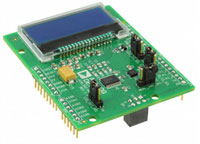By Analog Devices Inc 45

The Terasic DE10-Nano is a development kit based on an Intel SoC which combines the power of a Cyclone FPGA with a dual-core ARM® Cortex®-A9 processor. ADI offers many development boards that extend the functionality of the kit. Whether the user wants to measure real-world phenomena such as toxic gases, or dynamically adjust a power supply voltage, there likely is a solution to get them started. The DE10-Nano board itself is also a great example of how ADI ICs are critical to making an embedded system work.
Arduino Plug-Ins: Circuits from the Lab
ADI has developed hundreds of reference designs to help solve developers’ system level application challenges from mixed signal designs to software drivers and algorithm development. Circuits from the Lab Reference Designs:
Use the Arduino-compatible headers of the DE10-Nano to plug-in a variety of precision signal chain solutions from ADI. Most of these boards have firmware supported on existing ADI platforms, such as the ADICUP360 or ADICUP3029, and developers around the world are extending this to standard Arduino as well as the DE10-Nano environment.
QuikEval™ Plug-Ins: System Monitoring, Power Supplies, and More
The DE10-Nano includes a 14-pin QuikEval header that is compatible with hundreds of ADI evaluation boards from the legacy Linear Technology product lines. Some of these parts may be an enabling technology for the users' design, such as a precision ADC or DAC, or a low-noise PLL for a communications system. Other products perform critical auxiliary functions, such as system health monitoring (supply current, supply voltage, temperature, etc.) or dynamically adjusting power supplies.
The SPI or I2C signals on the DE10-Nano's QuikEval connector are connected to the HPS side of the Cyclone V SoC device. This means that the user will most likely communicate to these devices from within the Linux operating system running on the embedded processor. For parts without a Linux driver, it is possible to communicate directly through the /dev/i2c and /dev/spi device files. In both cases, there is Linduino code that can be used as a starting point for writing the code. Linduino code is intended for porting to "bare metal" (no operating system) embedded applications, but is still useful in gaining insight into how a particular device functions.
Downloadable Linduino Code Library